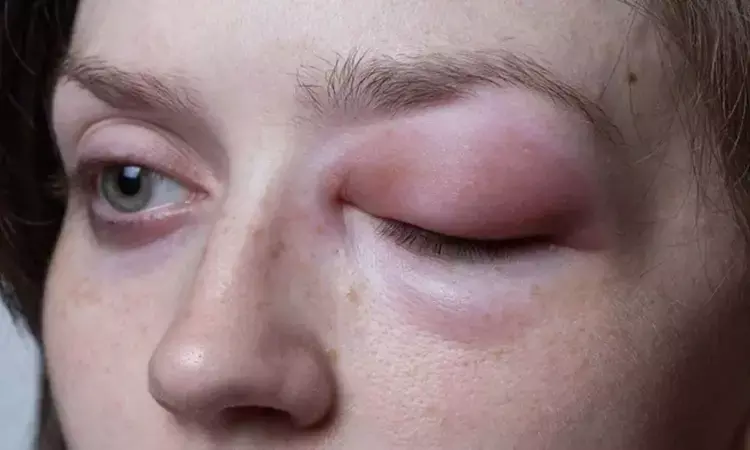- Home
- Medical news & Guidelines
- Anesthesiology
- Cardiology and CTVS
- Critical Care
- Dentistry
- Dermatology
- Diabetes and Endocrinology
- ENT
- Gastroenterology
- Medicine
- Nephrology
- Neurology
- Obstretics-Gynaecology
- Oncology
- Ophthalmology
- Orthopaedics
- Pediatrics-Neonatology
- Psychiatry
- Pulmonology
- Radiology
- Surgery
- Urology
- Laboratory Medicine
- Diet
- Nursing
- Paramedical
- Physiotherapy
- Health news
- Fact Check
- Bone Health Fact Check
- Brain Health Fact Check
- Cancer Related Fact Check
- Child Care Fact Check
- Dental and oral health fact check
- Diabetes and metabolic health fact check
- Diet and Nutrition Fact Check
- Eye and ENT Care Fact Check
- Fitness fact check
- Gut health fact check
- Heart health fact check
- Kidney health fact check
- Medical education fact check
- Men's health fact check
- Respiratory fact check
- Skin and hair care fact check
- Vaccine and Immunization fact check
- Women's health fact check
- AYUSH
- State News
- Andaman and Nicobar Islands
- Andhra Pradesh
- Arunachal Pradesh
- Assam
- Bihar
- Chandigarh
- Chattisgarh
- Dadra and Nagar Haveli
- Daman and Diu
- Delhi
- Goa
- Gujarat
- Haryana
- Himachal Pradesh
- Jammu & Kashmir
- Jharkhand
- Karnataka
- Kerala
- Ladakh
- Lakshadweep
- Madhya Pradesh
- Maharashtra
- Manipur
- Meghalaya
- Mizoram
- Nagaland
- Odisha
- Puducherry
- Punjab
- Rajasthan
- Sikkim
- Tamil Nadu
- Telangana
- Tripura
- Uttar Pradesh
- Uttrakhand
- West Bengal
- Medical Education
- Industry
Lanadelumab significantly reduces HAE attacks in long-term use: Study

A real-world study published in the International Archives of Allergy and Immunology found that 3 years of lanadelumab treatment led to a substantial decrease in hereditary angioedema (HAE) attacks. The proportion of patients experiencing monthly attacks dropped from 54% before treatment to just 9.8% after long-term use.
Hereditary angioedema is typified by recurring, erratic episodes of body swelling which affects both adults and children, with an estimated frequency of 1:50,000. The kallikrein-kinin cascade is dysregulated as a result of either a deficiency (HAE-C1INH-Type1) or dysfunction (HAEC1INH-Type2) of the C1 esterase inhibitor, which causes the clinical manifestations of HAE. Clinically, HAE attacks show up as nonpitting, nonpruritic edema that mostly affects the upper airway, abdominal organs, and subcutaneous tissue.
A monoclonal antibody called lanadelumab, which blocks plasma kallikrein, is authorized for the long-term prevention of HAE attacks in patients two years of age or older in the US and Europe, and 12 years of age or older in several other countries. Lanadelumab was approved for long-term prophylaxis in individuals with HAE based on clinical studies; yet, there is a lack of empirical evidence about the long-term usage of lanadelumab in HAE patients.
This research gathered information from the Adelphi Wave II Disease Specific Programme™, a cross-sectional, real-world survey of doctors and their HAE patients in the US, between January 2023 and January 2024. Physicians retrospectively recorded the frequency, severity, and quality of life of attacks prior to starting lanadelumab, as well as at 12, 24, and 36 months after starting the medication and throughout the survey.
Data on 51 patients who had been on lanadelumab for at least 3 years were reported by doctors. At 36 months after starting lanadelumab, 62.5% of patients had mild attacks, and none had very severe attacks in the year prior. Prior to starting lanadelumab, doctors reported that 49.0% of patients had mild attacks and 8.2% had very severe attacks.
Prior to starting lanadelumab, 54.0% of patients reported having at least one attack per month on average; at the time of the survey, that number had dropped to 9.8%. Before starting lanadelumab, 68.6% of patients had good or excellent quality of life; by the time of the survey, that number had risen to 88.2%.
Overall, patients receiving lanadelumab for at least 3 years saw improvements in attack frequency, disease severity, and quality of life in this real-world HAE research. After long-term usage, the percentage of patients who experienced monthly attacks decreased from 54% before therapy to just 9.8%.
Source:
Lumry, W. R., Davis-Lorton, M., Soteres, D., Earl, L., Wynne-Cattanach, K., Fox, D., Sing, K., Juethner, S., & Schultz, B. G. (2025). Long-term real-world outcomes in patients with hereditary angioedema receiving lanadelumab for 3 or more years. International Archives of Allergy and Immunology, 1–18. https://doi.org/10.1159/000546987
Neuroscience Masters graduate
Jacinthlyn Sylvia, a Neuroscience Master's graduate from Chennai has worked extensively in deciphering the neurobiology of cognition and motor control in aging. She also has spread-out exposure to Neurosurgery from her Bachelor’s. She is currently involved in active Neuro-Oncology research. She is an upcoming neuroscientist with a fiery passion for writing. Her news cover at Medical Dialogues feature recent discoveries and updates from the healthcare and biomedical research fields. She can be reached at editorial@medicaldialogues.in
Dr Kamal Kant Kohli-MBBS, DTCD- a chest specialist with more than 30 years of practice and a flair for writing clinical articles, Dr Kamal Kant Kohli joined Medical Dialogues as a Chief Editor of Medical News. Besides writing articles, as an editor, he proofreads and verifies all the medical content published on Medical Dialogues including those coming from journals, studies,medical conferences,guidelines etc. Email: drkohli@medicaldialogues.in. Contact no. 011-43720751


